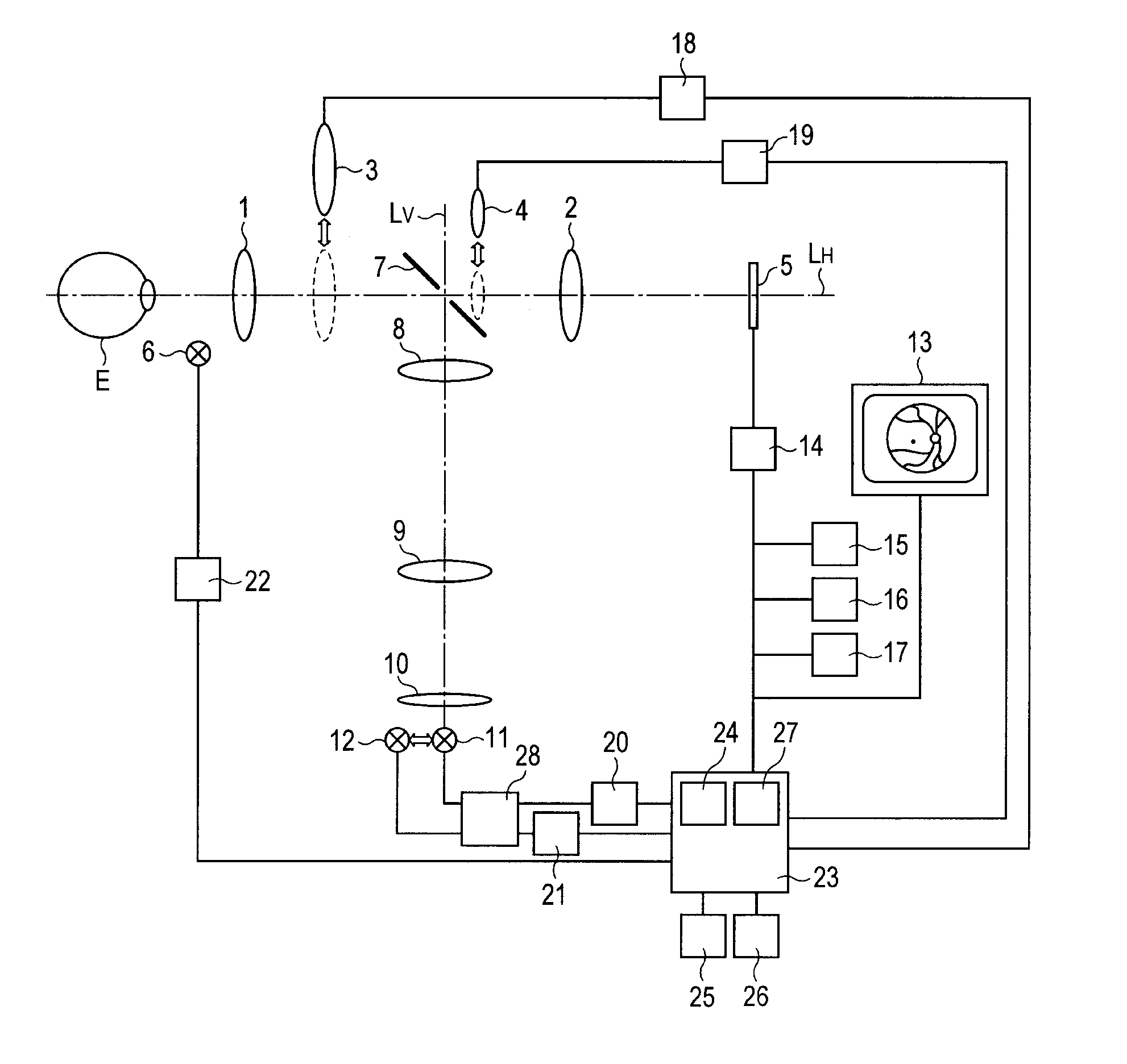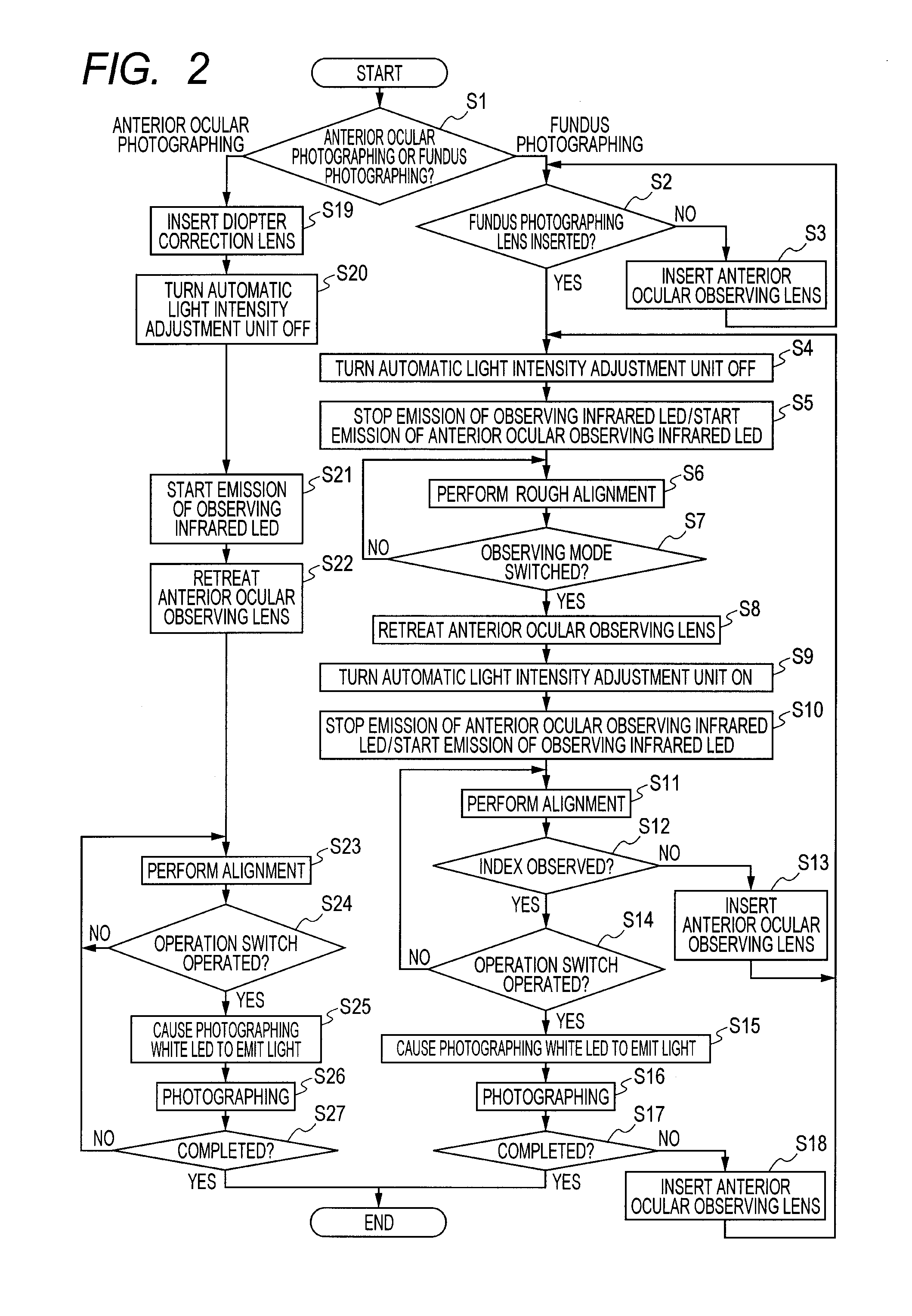Fundus camera and control method for the fundus camera
- Summary
- Abstract
- Description
- Claims
- Application Information
AI Technical Summary
Benefits of technology
Problems solved by technology
Method used
Image
Examples
first embodiment
[0024]In the following, a fundus camera having a fundus mode, an anterior ocular observation mode, and an anterior ocular photographing mode is described as an example.
[0025]FIG. 1 is a configuration diagram according to a first embodiment in which the present invention is applied to the fundus camera.
[0026]An objective lens 1 is disposed to oppose an eye E to be inspected. On an optical axis (path) LH of the objective lens 1, there are provided an image-forming lens 2, an anterior ocular observing lens 3 that is insertable and retreatable to and from the optical axis LH, a diopter correction lens 4 that is similarly insertable and retreatable to and from the optical axis LH, and a photographing element 5 having sensitivity to visible light and infrared light. In addition, at a substantially peripheral portion of the objective lens 1, an anterior ocular illumination infrared LED 6 for irradiating the anterior ocular segment of the eye E to be inspected, in particular a peripheral re...
second embodiment
[0074]The first embodiment has exemplified the configuration of the fundus camera having the fundus mode, the anterior ocular observation mode, and the anterior ocular photographing mode, in which the automatic light intensity adjustment function is disabled at the time of acquiring the anterior ocular image. In this configuration, in the observing and photographing mode, the anterior ocular observation mode and the anterior ocular photographing mode may be switched by a common member, that is, the same member, so as to configure an anterior ocular mode which is common to the anterior ocular observation mode and the anterior ocular photographing mode. Therefore, in this embodiment, the configurations that work as the anterior ocular observation switching unit and the anterior ocular photographing switching unit in the first embodiment are replaced by the control unit 23 and an associated configuration related to the light intensity adjustment as described above.
[0075]FIG. 3 is a con...
third embodiment
[0092]The first and second embodiments have exemplified the configuration in which the automatic light adjustment function is disabled at the time of acquiring an anterior ocular image so as to shorten photographing time. In this configuration, by changing the automatic light adjustment function, automatic light adjustment can be performed in a short period of time. This method is described as a third embodiment of the present invention.
[0093]The following description exemplifies a fundus camera which is configured so that automatic light adjustment is performed in the fundus mode while the automatic light adjustment is not performed in the anterior ocular observation mode, and automatic light intensity area adjustment is performed in the anterior ocular photographing mode, which limits an image signal area used for light intensity calculation to the sclera.
[0094]The configuration of the third embodiment of the present invention is the same as that illustrated in the first embodimen...
PUM
 Login to View More
Login to View More Abstract
Description
Claims
Application Information
 Login to View More
Login to View More - R&D
- Intellectual Property
- Life Sciences
- Materials
- Tech Scout
- Unparalleled Data Quality
- Higher Quality Content
- 60% Fewer Hallucinations
Browse by: Latest US Patents, China's latest patents, Technical Efficacy Thesaurus, Application Domain, Technology Topic, Popular Technical Reports.
© 2025 PatSnap. All rights reserved.Legal|Privacy policy|Modern Slavery Act Transparency Statement|Sitemap|About US| Contact US: help@patsnap.com



